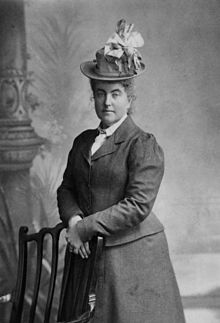
Back فاني بولوك ووركمان Arabic فانى بولوك ووركمان ARZ ফ্যানি বুলক ওয়ার্কম্যান Bengali/Bangla Fanny Bullock Workman Catalan Fanny Bullock Workman Czech Fanny Bullock Workman Welsh Fanny Bullock Workman German Fanny Bullock Workman Spanish Fanny Bullock Workman Basque فنی بالوک ورکمن Persian
 | |
| Personal information | |
|---|---|
| Birth name | Fanny Bullock |
| Main discipline | Mountaineer |
| Other disciplines | Cartographer, travel writer, explorer |
| Born | January 8, 1859 Worcester, Massachusetts, U.S. |
| Died | January 22, 1925 (aged 66) Cannes, France |
| Career | |
| Notable ascents | |
| Famous partnerships | William Hunter Workman |
| Family | |
| Spouse |
William Hunter Workman
(m. 1882) |
| Children | 2, including Rachel |
Fanny Bullock Workman (January 8, 1859 – January 22, 1925) was an American geographer, cartographer, explorer, travel writer, and mountaineer, notably in the Himalayas. She was one of the first female professional mountaineers; she not only explored but also wrote about her adventures. She set several women's altitude records, published eight travel books with her husband, and championed women's rights and women's suffrage.
Born to a wealthy family, Workman was educated in the finest schools available to women and traveled in Europe. Her marriage to William Hunter Workman cemented these advantages, and, after being introduced to climbing in New Hampshire, Fanny Workman traveled the world with him. They were able to capitalize on their wealth and connections to voyage around Europe, North Africa, and Asia. The couple had two children, but Fanny Workman was not a motherly type; they left their children in schools and with nurses, and Workman saw herself as a New Woman who could equal any man. The Workmans began their travels with bicycle tours of Switzerland, France, Italy, Spain, Algeria and India. They cycled thousands of miles, sleeping wherever they could find shelter. They wrote books about each trip and Fanny frequently commented on the state of the lives of women that she saw. Their early bicycle tour narratives were better received than their mountaineering books.
At the end of their cycling trip through India, the couple escaped to the Western Himalaya and the Karakoram for the summer months, where they were introduced to high-altitude climbing. They returned to this then-unexplored region eight times over the next 14 years. Despite not having modern climbing equipment, the Workmans explored several glaciers and reached the summit of several mountains, eventually reaching 23,000 feet (7,000 m) on Pinnacle Peak, a women's altitude record at the time. They organized multiyear expeditions but struggled to remain on good terms with the local labor force. Coming from a position of American privilege and wealth, they failed to understand the position of the native workers and had difficulty finding and negotiating for reliable porters.
After their trips to the Himalaya, the Workmans gave lectures about their travels. They were invited to learned societies; Fanny Workman became the first American woman to lecture at the Sorbonne and the second to speak at the Royal Geographical Society. She received many medals of honor from European climbing and geographical societies and was recognized as one of the foremost climbers of her day. She demonstrated that a woman could climb in high altitudes just as well as a man and helped break down the gender barrier in mountaineering.
© MMXXIII Rich X Search. We shall prevail. All rights reserved. Rich X Search